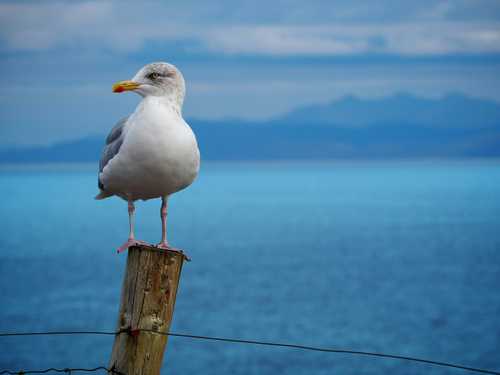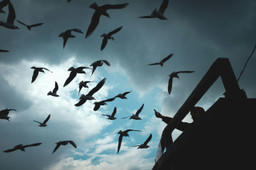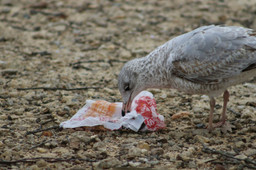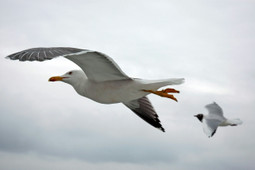
It feels fair to say that most people feel positively about wildlife – or at least certain elements of it. Even if someone’s scared of sharks or freaked out by creepy-crawlies, they’re still likely to appreciate the beauty of birdsong, or feel affectionate towards charismatic species like polar bears, big cats, lemurs, or dolphins. However, there are certain other species that – dependent on context – can elude this kind of affection: ‘pests’ (say, rats, cockroaches, pigeons), or animals which can threaten the livelihoods of those who depend directly upon farming (rabbits, elephants, wolves, to name but three).
But the spread of disease or damage to crops and livestock are valid reasons why particular animals aren’t universally loved. Sometimes species become disliked simply for a refusal to behave according to our notions of propriety. The pearl-clutching that can result from these situations betrays an all too human misunderstanding of the wildness of wild animals.
By way of example: people feel very strongly about seagulls. And generally not in a particularly positive way. This was exemplified in Scotland earlier this month, when the council for Dumfries and Galloway (DGC) committed to continue an £84,000 (US$103,790)-per-year “gull management strategy” to deter what is seen as the birds’ antisocial behavior.
Admittedly, with food being stolen from people’s hands, nesting pairs dive-bombing passersby to protect their chicks, noise issues (especially at dawn), and the mess caused by both the birds’ droppings and the rubbish bags they rip open, it’s not hard to understand why the gulls are unpopular with residents. Complaints about them in DGC’s main towns have dropped since it implemented its strategy, but since “avian flu has seen seagull numbers decline nationwide”, it’s difficult to assess whether this should be attributed to the council’s actions. However, if they are deemed a success, they may be replicated elsewhere in the UK. But why has coexistence with gulls become so problematic?

As of February this year, all five gull species which breed in Scotland have been shown to be experiencing “significant and serious declines”, particularly in respect of “naturally nesting” populations, with declines ranging from 44 to 78%. Though it may appear that urban populations of gulls are increasing, “there is limited data to back this up”; even if it is the case, it is occurring in response to human-caused “changes in food availability [including the depletion of fish stocks] and land use”, in addition to the effects of the current zoonotic avian flu outbreak – itself in part fuelled by “illegal trade of birds and bird products”. Given gulls’ kleptoparasitism – enabled by the intelligence that has allowed them to learn what is edible by observing humans – littering and accessible rubbish bins have made urban spaces desirable to these species. 🍟
In short, as is so frequently the case, we have brought this situation on ourselves. But, having been compelled to enter urban spaces in order to survive, gulls now find themselves persecuted for coming into conflict with us.
In the UK, the Wildlife and Countryside Act 1981 makes it illegal to kill or injure wild birds, or to remove or destroy their eggs or nests, while they are in use. Penalties can include a maximum fine of £5,000 (US$6,184) and/or six months in prison. (In the US, the Migratory Bird Treaty Act of 1918 provides similar protections.)
However, licenses allowing egg and nest removal can be granted by NatureScot, a public body of the Scottish Government. Thirty-seven such licenses were granted to DGC during 2023-24, with 660 eggs and 326 nests being removed during that period as a result. Given that the species’ natural-nesting populations have now been found to be in decline, these licenses may be less likely to be granted in future, meaning that councils may be forced to rely more heavily on other forms of deterrence. “Largely experimental” techniques already used by DGC include flying falcons over the town to discourage roof-nesting gulls (a “partial success”); the installation of spikes and water-sprayers on buildings (the sprayers’ infra-red sensors became ineffective in the summer); and the less high-tech expedient of putting up signs discouraging people from feeding the birds.

Alternatively, Paul Graham, professor of ecology and evolution of the University of Sussex – one of the authors of a study published last year which endorses gulls’ intelligence and “behavioural flexibility” – proposed the provision of “larger, more secure bins in public spaces and educating people not to leave leftover food lying around”. It’s also worth noting that, according to some studies, maintaining eye contact with “a scrounging gull” can be effective in putting it off.
These options certainly seem preferable when compared to independent council member David Slater’s concerns about whether contractors removing nests are sufficiently trained, and that they may be “throwing away live chicks”. He notes that by the last week of the 28 days it takes for the eggs to hatch, the chicks inside “are fully formed and whistling to each other”. The removal of young which are sufficiently developed to be able to communicate gives lie to the UK’s self-conception as a nation of animal lovers; it might be more accurate to say “a nation of sentimental hypocrites” or even “wildlife killers”.
Perhaps we would feel more clemency if we could look beyond the “bad reputation [gained by gulls] for stealing chips”. If we could see them afresh, perhaps we could come to appreciate the intelligence behind their mischievousness, their incredible, near-wraparound vision, and even their graceful beauty (the black-headed gull is particularly handsome). Perhaps then we might even pay attention to the fact that there’s not actually any such thing as a seagull; of the 54 species of gull, none are called this, and many don’t live by the sea. Admittedly, the similarities between certain species – and variations of appearance even within species, including plumage changes according to age, time of year, and breeding status – do make them notoriously difficult to identify. For the record, the most common species in Europe and the US is the herring gull: the quintessential gray-and-white ‘seagull’. (See brief primers on some of the gull species found in the UK and the US.)

It’s questionable whether judging a species according to its intelligence is a justifiable way to establish its worth, but we do seem inclined to value animals on this basis; at least within animal-loving circles, there is a particular affection for great apes, dogs, corvids, elephants, pigs, and even octopuses. Herring gulls have been observed using tools (namely, using bread as bait to lure goldfish to the surface of a Paris pond), yet it seems that any inconvenience we experience is enough to negate our admiration for such overt displays of intelligence. 🐟
Nevertheless, gulls are as much a part of the natural environment as any other more beloved species, and as deserving of protection, regardless of what Emma Caulfield, who runs the Winter Gull Survey, describes as “a bad rap for sometimes aggressive behaviour in the breeding season”. As she says, “They are part of our natural world and [are] just taking advantage of the hand that’s been dealt them.”
Featured photo by Michael Kurzynowski on Unsplash
Earth.fm is a completely free streaming service of 1000+ nature sounds from around the world, offering natural soundscapes and guided meditations for people who wish to listen to nature, relax, and become more connected. Launched in 2022, Earth.fm is a non-profit and a 1% for the Planet Environmental Partner.
Check out our recordings of nature ambience from sound recordists and artists spanning the globe, our thematic playlists of immersive soundscapes and our Wind Is the Original Radio podcast.
You can join the Earth.fm family by signing up for our newsletter of weekly inspiration for your precious ears, or become a member to enjoy the extra Earth.fm features and goodies and support us on our mission.
Subscription fees contribute to growing our library of authentic nature sounds, research into topics like noise pollution and the connection between nature and mental wellbeing, as well as funding grants that support emerging nature sound recordists from underprivileged communities.

